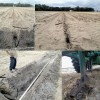Resumen
In terms of water use efficiency, the traditional seepage irrigation systems commonly used in areas with high water tables are one of the most inefficient methods of irrigation, though some irrigation management practices can contribute to better soil moisture uniformity. Subsurface drip irrigation systems apply water below the soil surface by microirrigation, improving the water distribution and time required to raise the water table for seepage irrigation. This 6-page fact sheet was written by Lincoln Zotarelli, Libby Rens, Charles Barrett, Daniel J. Cantliffe, Michael D. Dukes, Mark Clark, and Steven Lands, and published by the UF Department of Horticultural Sciences, March 2013.
Citas
ASABE Standards. 2001. S526.2: Soil and Water Terminology. St.Joseph, MI: ASABE.
Lamm F. R., J. P. Bordovsky, L. J. Schwankl, G. L. Grabow, J. Enciso-Medina, R. T. Peters, P. D. Colaizzi, T. P. Trooien, and D. O. Porter. 2012. "Subsurface Drip Irrigation: Status of the Technology in 2010." Transactions of the ASABE 55 (2): 483-491. https://doi.org/10.13031/2013.41387
Smajstrla A. G., S. J. Locascio, D. P. Weingartner, and D. R. Hensel. 2000. "Subsurface Drip Irrigation for Water Table Control and Potato Production." Applied Engineering in Agriculture 16(3): 225-229. https://doi.org/10.13031/2013.5147
Unless otherwise specified, articles published in the EDIS journal after January 1, 2024 are licensed under a Creative Commons Attribution-NonCommercial-NoDerivs 4.0 International (CC BY-NC-ND 4.0) license.

